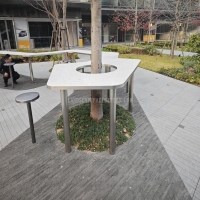Welcome to the website for landscape facilities products and knowledge.
How does the Landscape Round Table accommodate the needs of users with sensory processing disorders?
The Landscape Round Table represents a revolutionary approach to inclusive design, specifically engineered to accommodate individuals with sensory processing disorders. Traditional environments often present overwhelming stimuli that can trigger sensory overload, but this innovative furniture solution transforms spatial dynamics through thoughtful, evidence-based design principles.
At its core, the Landscape Round Table incorporates multiple sensory zones that allow users to self-regulate their environmental exposure. The design features adjustable height mechanisms that enable users to modify their position from seated to standing configurations, accommodating various sensory preferences and physical needs. The surface integrates tactile elements with alternating smooth and textured sections, providing discrete sensory input options without overwhelming users.
Acoustic considerations form another critical component of the design. The table incorporates sound-absorbing materials that dampen ambient noise, reducing auditory overstimulation common in shared spaces. Integrated personal listening zones allow users to connect assistive devices directly to the table's interface, enabling customized audio experiences without disturbing others.
Visual stimulation is carefully managed through the table's innovative lighting system. Unlike harsh overhead lighting found in conventional settings, the Landscape Round Table employs indirect, diffused LED lighting with adjustable color temperatures and intensity controls. Users can personalize their immediate visual environment, selecting from cool to warm spectrum lighting based on their sensory preferences and needs.
The circular configuration of the Landscape Round Table eliminates sharp corners and creates sight lines that reduce visual clutter, while the organic, flowing design prevents the creation of "dead zones" that can cause anxiety for some users. The material palette consists of natural, non-reflective surfaces that minimize glare and visual distortion.
Perhaps most importantly, the design incorporates clear wayfinding cues and predictable spatial organization that help users navigate the environment with confidence. The consistent layout patterns and color-coded sections provide visual structure without being overly rigid, supporting users who benefit from environmental predictability.
Research conducted across educational and workplace settings demonstrates that these design interventions significantly reduce stress responses in users with sensory processing challenges. By addressing tactile, auditory, visual, and proprioceptive needs simultaneously, the Landscape Round Table creates environments where neurodiverse individuals can participate fully without sensory barriers.
The continuing evolution of this design reflects an ongoing commitment to universal design principles, recognizing that environments accommodating sensory processing differences ultimately benefit all users through enhanced comfort, accessibility, and usability.
Related search:

Recommendation
An outdoor bar counter with stainless steel and terrazzo materials in an irregular shape